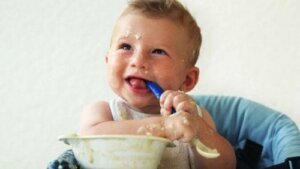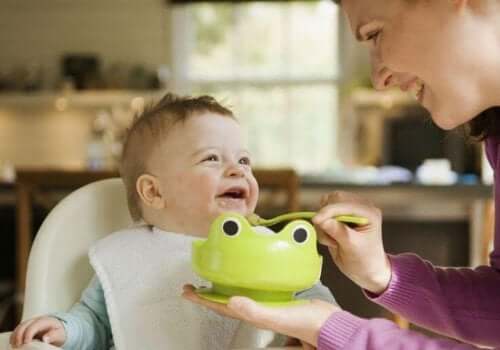The Relationship Between Eating and Language Development

As our little ones get bigger and bigger, they also acquire new skills and learn like sponges. And, over time and to the same extent, their diet should be modified. This not only has significant nutritional value, but it also has a significant impact on how they develop language. It’s important that you take the introduction of new foods very seriously as the pediatrician recommends it and that you don’t delay the introduction of semisolids and solids. In the following article, we’ll tell you more about the relationships between eating and language development
Eating and language development
A diet rich in a variety of textures and flavors is necessary, not only to guarantee a balanced diet and for our children to learn to eat different kinds of foods, but to contribute to the correct development of the oral and facial muscles that later it will influence language development.
Some specialists emphasize that the same muscles that we use to eat are those that we use to speak, and for this reason, it’s essential to have an orofacial musculature with the appropriate muscle tone and precise coordination to be able to articulate in a sequential way what we want to communicate.
The muscles are toned according to the type of food we eat (liquid, semi-liquid, semi-solid, and solid). For this reason, it’s important not to get stuck in textures that don’t stimulate muscle tone. Keep in mind that sometimes when children tend to speak very little or have delayed language development, it’s due to the fact that as they communicate, their speech is poorly understood and they manifest fatigue or tiredness when doing so. So, it’s important to monitor what they eat, how they do it, and how long it takes them to eat.

Pureed food – a big mistake
It’s increasingly common to find “big” children of 2 and 3 years with delayed language development who don’t eat solid foods and whose mothers or fathers have chosen to give them nothing but purees.
It’s not uncommon to hear excuses like “I prefer to liquefy everything and so I know that my child’s eating well”, or “when they feel a solid piece of food, they spit it out”, and even “they’re too lazy to chew”.
At this point, it’s important that you make sure to differentiate between a bad habit encouraged by mom and dad and a real problem that the child has when it comes to tolerating and swallowing solid foods.
How to make this distinction?
A child who has real sensory difficulty admitting solids has this difficulty with any solids, including junk food and candy. However, a child who’s selective about spitting chicken but not chocolate, for example, needs a little more perseverance on the part of adults to eat better.
Therefore, according to the suggestions of your pediatrician, it’s best to incorporate solid foods as much as possible.
Start small
Babies over the age of 6 months and under the age of one can begin to become familiar with the art of chewing with some bean grains or any other grain that’s soft. You can spoon one or two grains at a time, and it’s very fun to see the faces they make. They’ll probably find it a bit difficult at first to keep it in their mouth, but that’s exactly why they have to start exercising.
Remember not to force or scold them and allow them to adjust to this at their own pace.

Vegetables and fruits as a first option
You can also try some cooked vegetables that are very easy to chew with their gums, such as carrot, avocado, potato, beet, celery, banana, etc. The important thing is that they bite them very little, according to the age of your baby, and that they incorporate them into their daily diet in such a way that they become familiar with them and exercise all the muscles necessary for chewing and swallowing.
If your baby is one of those eaters who cries between one spoon of soup and another because they want more, do this exercise starting from the middle of their meal or towards the end so that the baby’s in a good mood to experiment. On the contrary, if they never want to eat, turn it into a game so that they enjoy the activity.
As you can see, there’s a close relationship between eating and language development, so be sure to follow your pediatrician’s recommendations regarding complementary feeding. And if you notice that your child’s having difficulties, don’t delay in discussing them with the specialist.
This text is provided for informational purposes only and does not replace consultation with a professional. If in doubt, consult your specialist.








